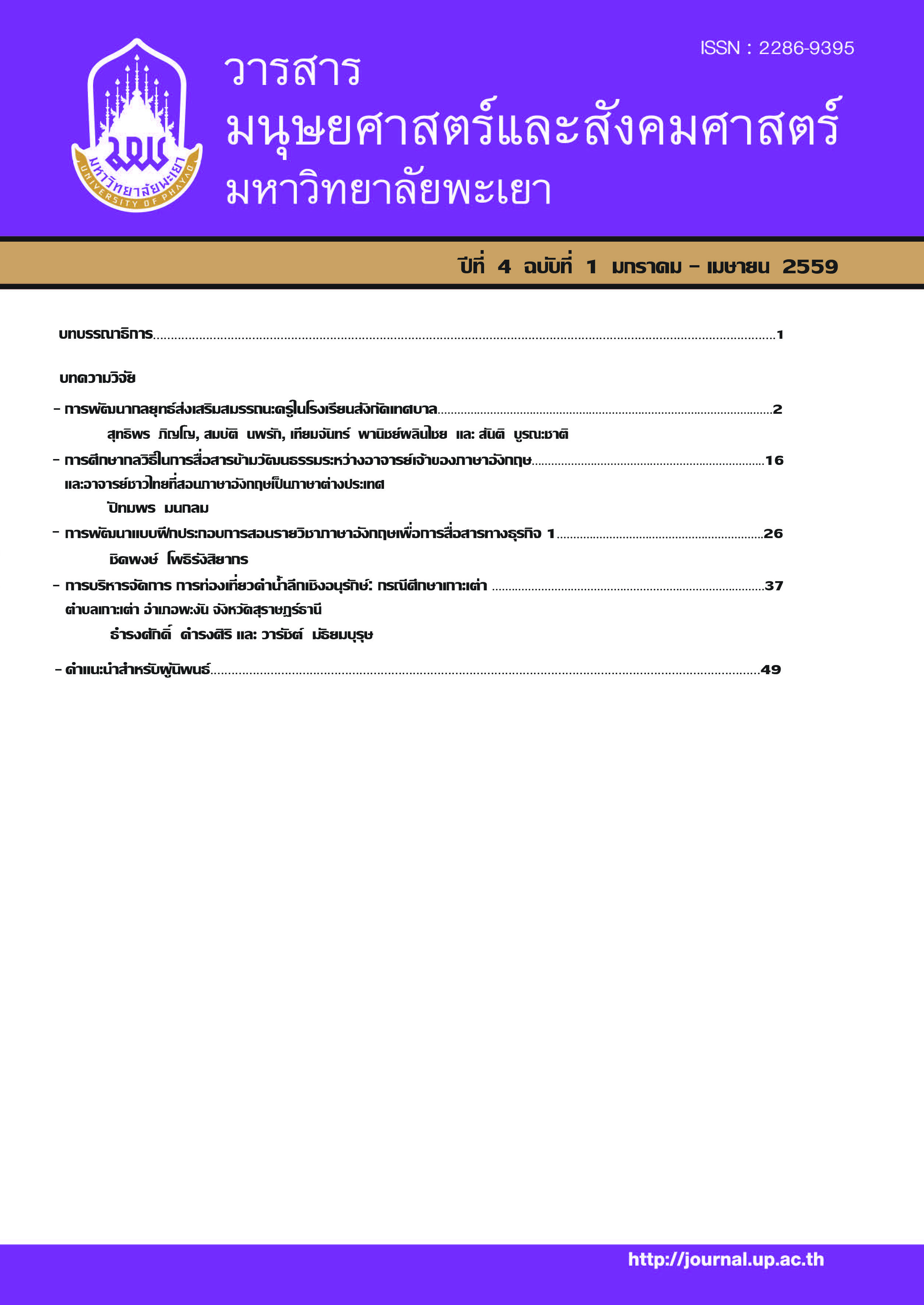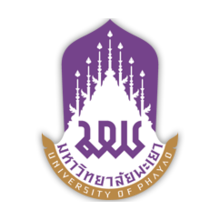Exploring Communication Strategies in Cross-Cultural Interaction Between Native English Teachers and Thai EFL Teachers
Keywords:
Cross-cultural interaction, Communication strategies, Native English teachers, Thai EFL teachersAbstract
The purpose of this study was to investigate cross-cultural interactions between Thai teachers who teach English as a foreign language (EFL) and native English-speaking teachers focusing on cross-cultural interaction apprehension and communication strategies (CSs) that Thai EFL teachers and native English-speaking teachers used in their conversations. The participants were high school teachers and university instructors in Phayao Province, Thailand. A total of 92 responses were gathered from 75 Thai EFL teachers and 17 native English-speaking teachers. The questionnaire and interview were used to collect data. The results of the study show that native English-speaking teachers had lower cross-cultural interaction apprehension than Thai EFL teachers. A majority of the participants regularly used communication strategies while interacting with people who come from different languages or cultures such as body language. There was a significant correlation between cross-cultural interaction apprehension and communication strategies in Thai EFL teachers, but there was no significant correlation between cross-cultural interaction apprehension and communication strategies in native English-speaking teachers. In addition, the way to use communication strategies between the Thai EFL teachers and the native English-speaking teachers were not significantly different. Moreover, the results show there was a significant difference in the cross-cultural interaction anxiety between the Thai EFL teachers and the native English teachers.
References
Baker W. (2009). Intercultural awareness and intercultural communication through English: an investigation of Thai English language user in higher education. Southampton: University of Southampton.
Baker W. (2012). English as a lingua franca in Thailand: Characterisations and implications." Englishes in Practice 1.1.
Barnett GA, Lee M. (2003). lssues in lntercultural Communication Research, Cross-cultural and intercultural communication, SAGE publication.
Bentley JH. (1996). Cross-Cultural Interaction and Periodization in World History, The American Historical Review 101(3):749-770.
Berlo DK. (1960). The Process of Communication, New York: Holt, Rinehart and Winston.
Bialystok E. (1983). "Some factors in the selection and implementation of communication strategies." Strategies in interlanguage communication: 100-118.
Bialystok E. (1990). Communication strategies. Oxford: Blackwell.
Bongaerts T, Poulisse N. (1989). Communication strategies in L1 and L2: Same or different? Applied Linguistics: 253-268.
Campbell DT, Fiske DW. (1959). Convergent and discriminant validation by the multitrait-multimethod matrix. Psychological bulletin: 56(2), 81.
Carter CC. (2000). Saving Face in Southeast Asia: The Implementation of Prepackaged Plans of Reorganization in Thailand, Malaysia, and Indonesia: 295.
Cervantes CAR, Roux R. (2012). The Use of Communication Strategies in the Beginner EFL Classroom. Gist: Revista Colombiana de Educación Bilingüe, (6): 111-128.
Chang CW. (2012). Exploring the beliefs of native and non-native English speaking kindergarten teachers in Taiwan, International Journal of Research Studies in Language Learning, 1(1).
Cheng W. (2002). Intercultural communication between Native and Non-native speakers of English, Hong Kong: University of Hong Kong.
Chomsky N. (1965). Aspects of the Theory of Syntax. The MIT press: Vol. 11.
Creswell JW. (2003). Research design: Qualitative, quantitative, and mixed methods approaches. Sage publications.
Culhane SF. (2004). An intercultural interaction model: acculturation attitudes in second language acquisition. Electronic. Journal of Foreign Language Teaching, 1(1): 50-61.
Dörnyei Z, Csizér K. (2005). The effects of intercultural contact and tourism on language attitudes and language learning motivation. Journal of Language and Social Psychology, 24(4):327-357.
Dörnyei Z, Kormos J. (1998). Problem-solving mechanisms in L2 communication. Studies in Second Language Acquisition, 20(3): 349-385.
Dörnyei Z, Scott ML. (1997). Communication strategies in a second language: Definitions and taxonomies. Language learning, 47(1): 173-210.
Dörnyei Z. (1995). On the teachability of communication strategies. Tesol Quarterly, 29(1): 55-85.
Faux II, WV, Young R. (2011). Description of Difficult Conversation between Native and Non-Native English Speakers: In-group Membership and Helping Behaviors, The Qualitative Report, 16(2): 494-508.
Færch C, Kasper G. (1983). Plans and strategies in foreign language communication. In C. Færch and G. Kasper (Eds.), Strategies in interlanguage communication. Harlow, England: Longman: 20–60.
Graham ID, Logan J, Harrison MB, Straus SE, Tetroe J, Caswell W, et al. (2006). Lost in knowledge translation: time for a map?, Journal of continuing education in the health professions, 26(1): 13-24.
Gudykunst WB, Kim YY. (1997). Communicating with strangers: An approach to intercultural communication, New York: McGraw-Hill.
Hall ET. (1959). The Silent Language, New York: Doubleday.
Horwitz E. (1996). Even teachers get the blues: recognizing and alleviating language teacher’ feelings of foreign language anxiety. Foreign Language Annals 29(3): 365-372.
Horwitz E, Young D. (1991). Theory and Research to Classroom Implications. Englewood Cliffs, N.J.: Prentice Hall.
Hurn BJ, Tomalin B. (2013). Cross-cultural communication: Theory and practice. N.P., Palgrave Macmillan.
Irwin H. (1996). Communicating with Asia: Understanding people and customs, N.P. Allen & Unwin.
Kachru B. (1981). Models for non-native Englishes. In Kachru B. (ed.), the other tongue: English across cultures. Chicago: University of Illinois Press.
Kachru BB. (1992). Models for non-native Englishes. The other tongue: English across cultures, University of Illinois Press, 2: 48-74.
Kachru BB. (1997). World Englishes and English-using communities. Annual Review of Applied Linguistics, 17: 66-87.
Kachru BB. (1998). English as an Asian language. Links and letters: 89-108.
Kachru B, Quirk R. (1981). Introduction, The pragmatics of nonnative varieties of English in Smith, L. E. (Ed.), English for cross culture communication, London: Macmillan.
Kilickaya F. (2009). World Englishes, English as an international language and applied linguistics. English Language Teaching, 2(3): 35.
Klopf DW. (1984). Cross-cultural apprehension research: A summary of Pacific basin studies. In Daly, J. A. & McCroskey, J. C. (Eds.). Avoiding communication: Shyness, reticence, and communication apprehension. Beverly Hills, CA: Sage: (pp. 146-157).
Leary MR, Kowalski RM. (1995). Social anxiety. New York: Guilford Press.
Matthews LC, Thakkar B. (2012). The impact of Globalization on cross-cultural communication, Intech, 13: 325-340.
Martin JN, Nakayama TK. (2013). Intercultural Communication in Contexts, Sixth edition, The McGraw-Hill Companies, Inc.
McCroskey JC. (1977). Oral communication apprehension: A summary of recent theory and research. Human communication research, 4(1): 78-96.
McCroskey JC, Gudykunst WB, Nishida T. (1985). Communication apprehension among Japanese students in native and second language. Communication Research Reports, 2:11-15.
Melinte IE. (2012). Cultural transfer and the Cross-cultural impact of foreign languages, International Journal of Communication Research, 2(1): 58-63.
Mei A, Nathalang S. (2010). Use of communication strategies by Chinese EFL learners. Chinese. Journal of Applied Linguistics, 33(3): 110-125.
Miller K. (2005). Communication Theories: Perspectives, Processes, and Contexts. New York: McGraw-Hill Higher Education; 2 editions.
Movius L. (2010). ‘Cultural Globalisation and Challenges to Traditional Communication Theories’, PLATFORM: Journal of Media and Communication, 2(1): 6-18.
Mulder N. (1985). Everyday life in Thailand, N.P., Duang Kamol.
Najafbagy R. (2008). Problems of Effective Cross-cultural Communication and Conflict Resolution, Palestine-Israel Journal of Politics, Economics & Culture 2008, 15/16(4):146-150.
Nakatani Y. (2005). The Effects of Awareness-Raising Training on Oral Communication Strategy Use. The Modern Language Journal, 89(1): 76-91.
Neuliep JW. (2012). Intercultural Communication: A Contextual Approach, 5th edition, N.P., Sage publications, Inc.
Neulip JW, McCroskey JC. (1997). The development of intercultural and interethnic communication apprehension scales. Communication Research Report, 14(2): 145-156.
Oyserman D, Coon HM, Kemmelmeier M. (2002). Rethinking individualism and collectivism: evaluation of theoretical assumptions and meta-analyses. Psychological bulletin:128(1), 3.
Singer MR. (1987). Intercultural Communication: A Perceptual Approach, New Jersey: Prentice-Hall.
Tarone E. (1977). Conscious communication strategies in interlanguage: A progress report. In Brown, H. D., Yorio, C. A. and Crymes, R. C. (Eds.), On TESOL’77: (pp.194-203). Washington: TESOL.
Tarone E. (1980). Communication strategies, foreigner talk, and repair in interlanguage. Language learning, 30(2): 417-428. N.P., n.p.
Tarone E. (1981). Some thoughts on the notion of communication strategy. TESOL quarterly, 15(3), 285-295.
Váradi T. (1980). Strategies of target language learner communication: Message adjustment. In Paper presented at the 6th Conference of the Romanian-English Linguistics Project, Timisoara. Published in IRAL, 18, 59-71.
Wang MM, Brislin R, Wang W, Williams, D, Chao JH. (2000). Turning bricks into jade: Critical incidents for mutual understanding among Chinese and Americans. Yarmouth, ME: Intercultural Press.
Watzlawick P, Beavin Bavelas J, Jackson DD. (1967). Pragmatics of Human Communication: A Study of Interactional Patterns, Pathologies and Paradoxes. W.W. Norton &Company, New York, London, 51.
Williams R. Culture is ordinary (1958). Cultural theory: an anthology, 2011:53-59.
Wong C. (2009). Are native speaker “Good” language instructors? A case study of untrained ESL tutors. ARECLS, Vol.6:122-140.
Yuan CW, Setlock LD, Cosley D, Fussell SR. (2003). Understanding informal communication in multilingual contexts. In Proceedings of the 2013 conference on Computer supported cooperative work: 909-922.
Zohrabi M. (2013). Mixed Method Research: Instruments, Validity, Reliability and Reporting Findings. Theory and Practice in Language Studies, 3(2), 2013: 254-262.
Downloads
Published
How to Cite
Issue
Section
License
ผู้นิพนธ์ต้องรับผิดชอบข้อความในบทนิพนธ์ของตน มหาวิทยาลัยพะเยาไม่จำเป็นต้องเห็นด้วยกับบทความที่ตีพิมพ์เสมอไป ผู้สนใจสามารถคัดลอก และนำไปใช้ได้ แต่จะต้องขออนุมัติเจ้าของ และได้รับการอนุมัติเป็นลายลักษณ์อักษรก่อน พร้อมกับมีการอ้างอิงและกล่าวคำขอบคุณให้ถูกต้องด้วย
The authors are themselves responsible for their contents. Signed articles may not always reflect the opinion of University of Phayao. The articles can be reproduced and reprinted, provided that permission is given by the authors and acknowledgement must be given.








